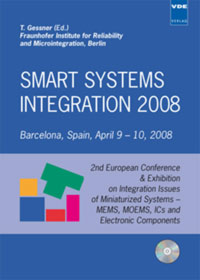Microcantilever-based sensor array tor amine detection in agro-tood applications
Conference: Smart Systems Integration 2008 - 2nd European Conference & Exhibition on Integration Issues of Miniaturized Systems - MOMS, MOEMS, ICS and Electronic Components
04/09/2008 - 04/10/2008 at Barcelona, Spain
Proceedings: Smart Systems Integration 2008
Pages: 3Language: englishTyp: PDF
Personal VDE Members are entitled to a 10% discount on this title
Authors:
Adami, Andrea; Decarli, Massimiliano; Lorenzelli, Leandro; Guarnieri, Vittorio; Malfatti, Mattia (Fondazione Bruno Kessler, Trento, Italy)
Apetrei, Constantin; Mendez, Maria Luz Rodriguez (University of Valladolid, Valladolid, Spain)
Abstract:
In industry and food supply chain there is an increasing need for integrated monitoring system to assure product quality. In particular, in the fishing industry, the detection of amines with an integrated system can allow real time and on-field analyses of products during the whole production and delivering process. This work presents the development of silicon microcantilever-based sensor arrays designed for integration in a chromatographic system for food quality monitoring applications. Microcantilevers are MEMS-structures suitable for chemical sensing; sensitivity to specific analytes can be achieved by coating the beam surface with proper chemically sensitive films. Analyte adsorption onto the surface affects both resonance frequency and beam bending, leading to different read-out approach which can be also combined. In this work, four-beam arrays have been designed and realised with a CMOS-compatible process in order to monitor the shift of the resonant frequency due to mass adsorption on the beam surface. The realised devices have been designed to work up to the third resonance mode in order to take advantage of the higher working frequencies, and in the frequency range from 10 to 180kHz. An integrated piezoresistive Wheatstone bridge read-out has been used in order to enhance sensitivity and to reduce read-out temperature dependence. The selected sensitive materials were Lutetium and Cobalt-Phtalocyanines. The read-out electronic that has been developed is based on a feedback system for measuring the frequency shift of the beam, allowing an increase of the resonance quality factor and frequency resolution of more than one order of magnitude. The selected configuration uses a PLL in locked state to follow the frequency of the cantilever and give the signal to the piezo-driver in order to maintain the system at resonance.


